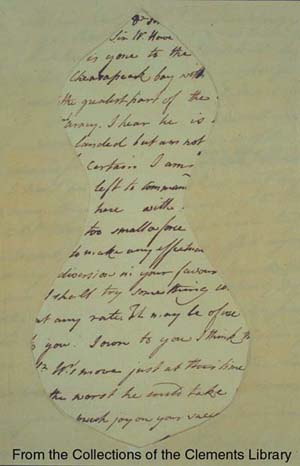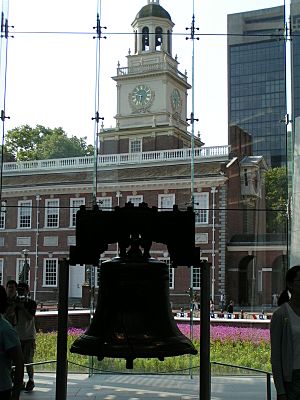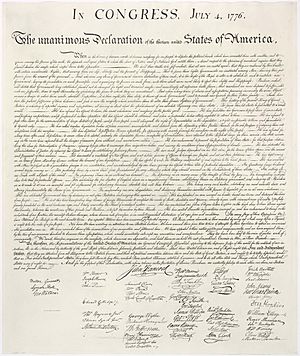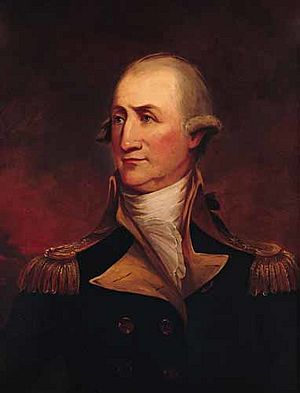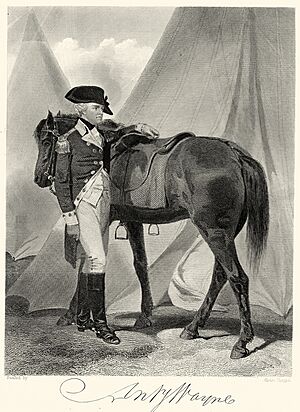Pennsylvania in the American Revolution facts for kids
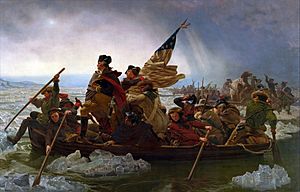
Pennsylvania was a super important place during the American Revolution. This state, especially the city of Philadelphia, played a huge role in America becoming independent.
One of America's Founding Fathers, Robert Morris, once said that Philadelphia was like the "heart" of the United States. It was central, had lots of trade, and many skilled workers.
The American Revolution wasn't just a war. It was also about how the people in the Thirteen Colonies started to think differently about being ruled by Great Britain. John Adams, another Founding Father, said that the real revolution happened in people's minds between 1760 and 1775, even before any fighting started. People learned and changed their opinions about how much power the British Parliament should have over the colonies.
Contents
Key Military Groups in Pennsylvania
- Pennsylvania Line of the Continental Army
- Pennsylvania Militia Units
- First Troop Philadelphia City Cavalry - This is the oldest military unit in the United States that has been serving continuously!
- Pennsylvania Navy
Pennsylvania's Government During the Revolution
- Pennsylvania Provincial Conference
- Pennsylvania Constitution of 1776
- Supreme Executive Council of the Commonwealth of Pennsylvania
Important Events in Pennsylvania
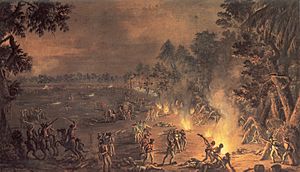
- Philadelphia Tea Party (October 16, 1773): Like the Boston Tea Party, colonists in Philadelphia protested British taxes by sending tea ships back to England.
- First Continental Congress (September 5 to October 26, 1774): Leaders from the colonies met in Philadelphia to discuss their problems with Britain.
- Second Continental Congress (May 10, 1775): This group continued to meet and eventually decided to declare independence.
- Olive Branch Petition (July 1775): A final attempt by the Congress to make peace with King George III. It was rejected.
- Declaration of the Causes and Necessity of Taking Up Arms (July 1775): This document explained why the colonists were ready to fight.
- Continental Marines Formed (November 10, 1775): Congress decided to create two battalions of Marines. They needed good sailors to serve during the war.
- Lee Resolution (July 2, 1776): This resolution officially called for the colonies to be independent.
- Declaration of Independence (1776): Signed in Philadelphia, this famous document declared the colonies' freedom from Britain.
- George Washington's crossing of the Delaware River (December 25, 1776): General Washington led his army across the icy Delaware River to surprise and defeat German soldiers (Hessians) fighting for the British at Trenton. This victory greatly boosted American spirits and kept the army together.
- US Flag Adopted (June 14, 1777): The Continental Congress decided the new flag would have 13 red and white stripes and 13 white stars on a blue background.
- Philadelphia Campaign (1777–1778): The British tried to capture Philadelphia, which was the American capital at the time.
- Battle of Brandywine (September 11, 1777): This was the largest battle of the American Revolution, with many troops fighting for 11 hours.
- During this battle, a British sharpshooter had a chance to shoot a high-ranking American officer but chose not to. Later, he heard it might have been General Washington!
- Gilbert du Motier, Marquis de Lafayette, a French officer, fought in his first battle here and helped organize the American retreat.
- Casimir Pulaski, a Polish officer, also fought here. His quick actions saved George Washington's life and helped the American army retreat safely. He became a brigadier general in the Continental Army cavalry.
- Battle of the Clouds (September 16, 1777): A huge storm stopped a battle from happening near Malvern, Pennsylvania. The rain ruined many American cartridges, so Washington's army had to retreat.
- Battle of Paoli (September 20, 1777): Also known as the Paoli Massacre, this was a surprise attack by the British on American troops.
- Siege of Fort Mifflin (September 26 to November 16, 1777): This fort defended Philadelphia. Its long siege delayed the British navy, helping the American army move to Valley Forge.
- Battle of Germantown (October 4, 1777): Another major battle fought near Philadelphia.
- Articles of Confederation and Perpetual Union Created (November 15, 1777): This was the first plan for how the new United States government would work.
- Valley Forge winter encampment (December 1777 to June 1778): The Continental Army spent a very harsh winter here, training and trying to survive.
- An Act for the Gradual Abolition of Slavery (March 1, 1780): Pennsylvania's legislature passed this law, one of the first steps to end slavery in the Western Hemisphere.
- Pennsylvania Line Mutiny (January 1, 1781): Some Pennsylvania soldiers protested their harsh conditions and lack of pay.
- Pennsylvania Mutiny of 1783 (June 20, 1783): Soldiers protested again, leading to Congress temporarily leaving Philadelphia.
Historic Sites and Museums
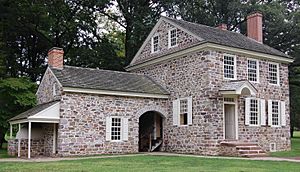
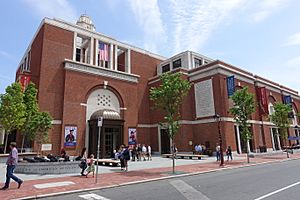
Battlefields You Can Visit
- Brandywine Battlefield Historic Site: This park and museum in Delaware and Chester Counties shows where the Battle of Brandywine took place. You can see where Generals Washington and Lafayette had their headquarters.
- Birmingham Friends Meetinghouse: During the Battle of Brandywine, this building was used as a hospital. Soldiers from both sides are buried in a common grave here.
- Battle of Germantown Sites:
- Cliveden (Benjamin Chew House) (Philadelphia, PA): Part of the Battle of Germantown happened around this historic house.
- Peter Wentz Homestead: George Washington used this house as his headquarters before and after the Battle of Germantown.
- Fort Mifflin (Philadelphia, PA): You can visit this fort, which was under siege by the British. You can still see marks from the artillery attacks on its walls.
- Fort Washington State Park: This park preserves part of the site of the Battle of White Marsh.
- Wyoming Monument: A monument at the site of the Wyoming Valley battle.
Other Important Historical Places
- Carpenters' Hall (Philadelphia, PA): The First Continental Congress met here in 1774.
- Fort Pitt Museum (Pittsburgh, PA): Learn about the history of Fort Pitt.
- Gen. Horatio Gates House and Golden Plough Tavern (York, PA): When Philadelphia was occupied, the Continental Congress met in York, and the Articles of Confederation were written here.
- Independence National Historical Park (Philadelphia, PA): This huge park includes many famous places like Independence Hall (where the Declaration of Independence was signed), the Liberty Bell, and the Benjamin Franklin Museum.
- Museum of the American Revolution (Philadelphia, PA): This museum tells the story of the American Revolution with amazing exhibits.
- Valley Forge National Historical Park (Montgomery and Chester Counties, PA): This national park preserves the site where the Continental Army camped during the harsh winter of 1777–1778. You can see Washington's Headquarters here.
- Washington Crossing Historic Park (Washington Crossing, Bucks County, PA): This park tells the story of George Washington's famous crossing of the Delaware River.
Libraries and Archives
- American Philosophical Society: This society has a huge collection of historical documents, especially about the American Revolution.
- Historical Society of Pennsylvania (Philadelphia, PA): A great place to find historical records and books about Pennsylvania.
- Library Company of Philadelphia: Founded by Benjamin Franklin, this library also has many historical documents and exhibits.
Other Memorials
- Tomb of the Unknown Revolutionary War Soldier (Philadelphia, PA): A memorial for soldiers who died in the Revolution whose identities are unknown.
- Washington–Rochambeau Revolutionary Route: This historic trail marks the path taken by American and French armies in 1781 on their way to the Battle of Yorktown.
Key Documents from Pennsylvania
- Letters from a Farmer in Pennsylvania (1767-1768): Essays by John Dickinson that helped explain why colonists were upset with British rule.
- Petition to the King (1774): A request sent to King George III asking him to repeal unfair laws.
- Common Sense (1775-1776): A very popular pamphlet by Thomas Paine that convinced many colonists to support independence.
- Declaration of Independence (1776): The famous document declaring America's freedom.
- Pennsylvania Constitution of 1776 (1776): Pennsylvania's first constitution as an independent state.
- Articles of Confederation (1777): The first agreement among the 13 founding states that served as the first constitution.
- An Act for the Gradual Abolition of Slavery (1780): Pennsylvania's law to slowly end slavery.
Important People from Pennsylvania
- Ann Bates: A loyalist spy who supported the British.
- Benjamin Chew: A lawyer and judge.
- George Clymer: A signer of the Declaration of Independence and the Constitution.
- John Dickinson: Known as the "Penman of the Revolution" for his writings. He helped draft many important documents like the Petition to the King and the Articles of Confederation.
- Benjamin Franklin: A famous author, scientist, inventor, and diplomat. He helped write the Declaration of Independence and the Constitution.
- Joseph Galloway: A delegate to the First Continental Congress who remained loyal to Britain.
- Jared Ingersoll: A lawyer and statesman who signed the U.S. Constitution.
- Brigadier General William Irvine: A general in the Continental Army.
- Robert Morris: Known as the "Financier of the Revolution" because he helped raise money for the war. He signed the Declaration of Independence, the Articles of Confederation, and the Constitution.
- John Morton: His vote was key in Pennsylvania's decision to support the Declaration of Independence.
- Peter Muhlenberg: A general in the Continental Army.
- Joseph Reed: A delegate to the Continental Congress and a leader in Pennsylvania's government.
- Dr. Benjamin Rush: A doctor, social reformer, and signer of the Declaration of Independence.
- Peggy Shippen: The second wife of Benedict Arnold, who became a spy for the British.
- Major General Arthur St. Clair: A general in the Continental Army.
- Samuel Van Leer: An ironmaster who supplied the army during the war.
- Brigadier General Anthony Wayne: A brave general in the Continental Army.
- James Wilson: A signer of the Declaration of Independence and the Constitution, and one of the first Supreme Court justices.
- Sarah ("Sally") Wister: A young girl who wrote a journal about her experiences during the British occupation of Philadelphia.
How Pennsylvania Remembers the Revolution
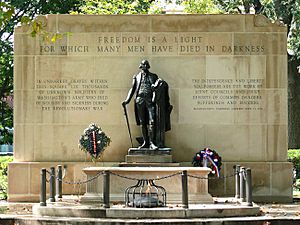
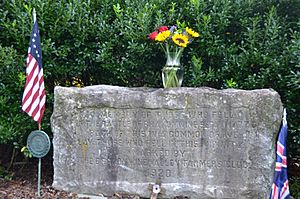
Many places in Pennsylvania are named after important figures from the American Revolution. For example, 19 of Pennsylvania's 67 counties are named after military and political leaders from that time, like Adams, Franklin, and Washington counties.
Independence Hall, where the Declaration of Independence was signed, is now a UNESCO World Heritage Site. This means it's recognized as a very important place for everyone in the world.
Valley Forge National Historical Park was given to the nation in 1976 and is now a National Park Service site, preserving the memory of the Continental Army's winter encampment.
Groups like the American Battlefield Trust are working to save and protect Revolutionary War battlefields in Pennsylvania, including the Brandywine battlefield.
Many monuments and memorials across Pennsylvania honor the people and events of the Revolution. These include the Tomb of the Unknown Revolutionary War Soldier in Philadelphia and the National Memorial Arch at Valley Forge.
There are also many societies, like the Sons of the American Revolution and Daughters of the American Revolution, whose members are descendants of people who lived during the Revolution. They help keep the history alive.



